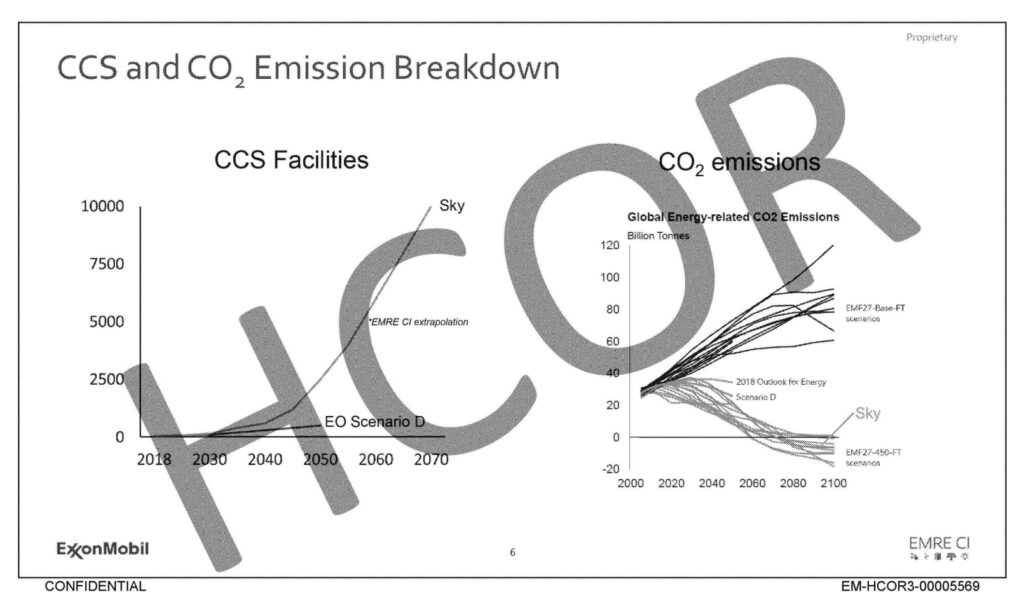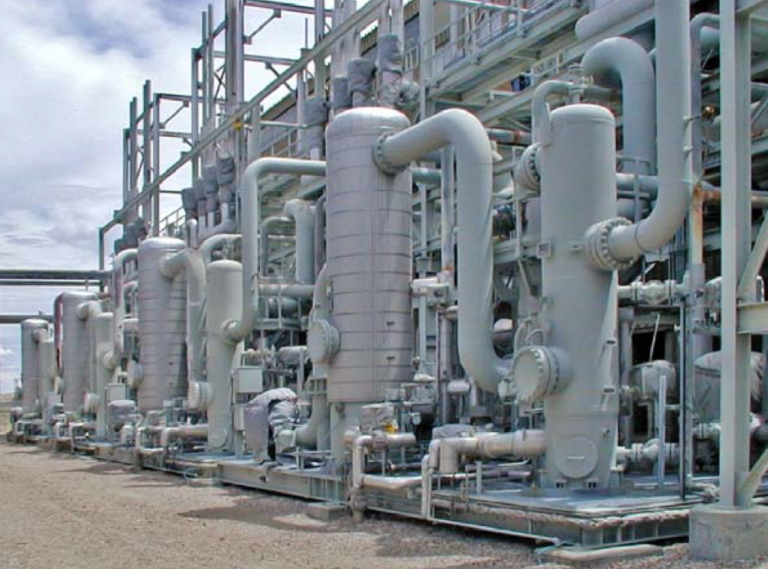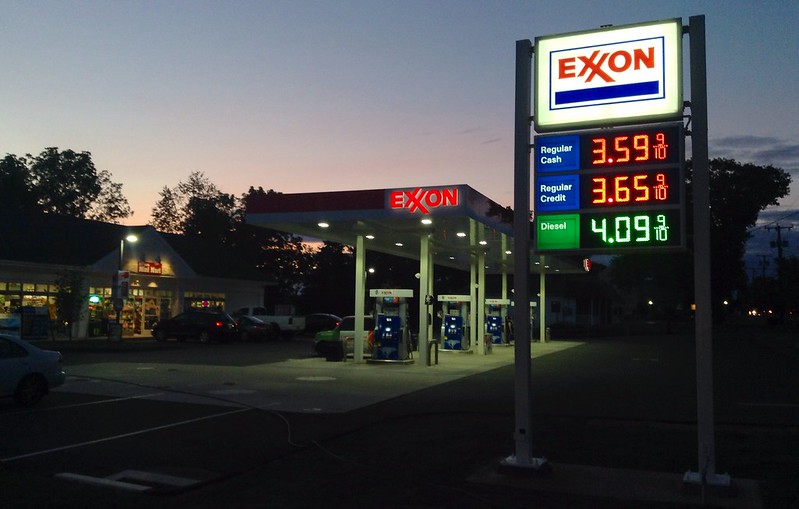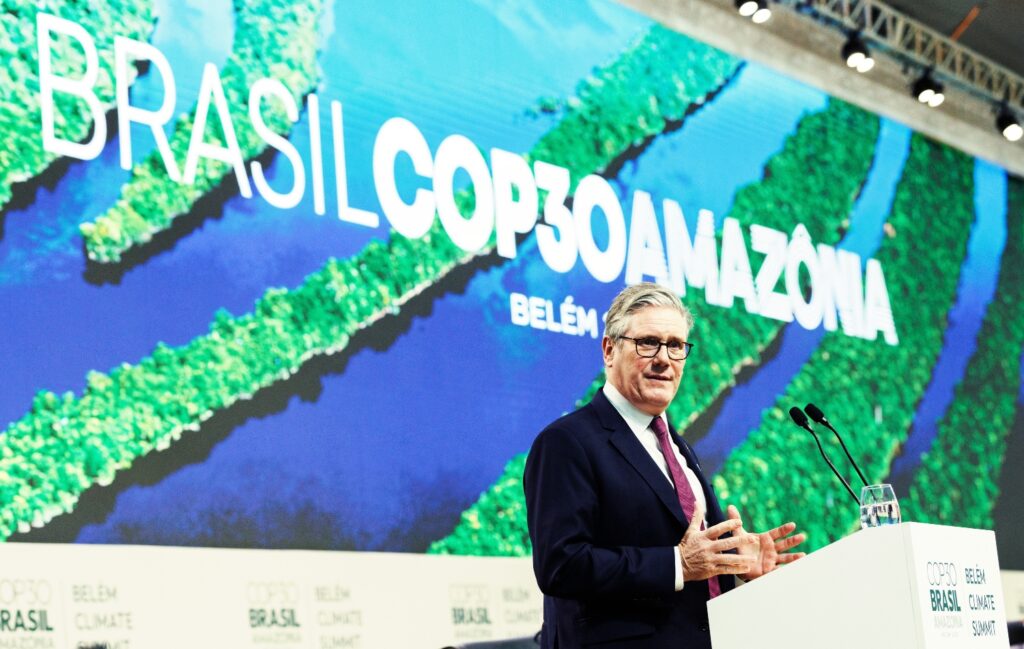ExxonMobil saw a “limited” role for carbon capture and storage (CCS) projects in fighting climate change, but still promoted the technology in its advertising campaigns, internal company documents show.
The documents, published by Congressional investigators, included a presentation dated April 2, 2018, that laid out an ExxonMobil scenario for what the global energy mix could look like in 2050 if countries enacted aggressive climate policies after 2024.
Marked “confidential,” the presentation introduced “Scenario D,” where the price of carbon is high, fossil fuel production and consumption had significantly declined, and economic growth had started to contract. Scenario D forecast much lower emissions than ExxonMobil’s public projection for the 2050 global energy portfolio, its 2018 Energy Outlook.
The presentation compared Scenario D to competitor Shell’s Sky Scenario, a public document produced by Shell to show pathways for achieving the goals for the 2015 Paris climate agreement.
Scenario D envisioned fewer than 500 carbon capture and storage sites to be operating globally by 2050, with much of the drop in emissions driven by reductions in energy demand. Shell’s Sky scenario, by contrast, saw a much bigger roll-out of the technology, with closer to 10,000 CCS facilities deployed by 2070. “CCS and hydrogen are deployed, but global scale is limited,” Exxon stated in its slide deck on Scenario D.

“The presentation appears to be a comparison of Shell’s very-rosy Sky scenario to what was likely ExxonMobil’s lowest-carbon emissions scenario from the 2018 Energy Outlook process,” Lindsey Gulden, a data scientist formerly employed by ExxonMobil who reviewed the presentation, told DeSmog.
“I interpret these now-public slides to show ExxonMobil’s 2018-era viewpoint regarding the ‘best-case scenario’ for the total global carbon-sequestration of CCS implemented by all operators,” Gulden said.
“In 2018, while ExxonMobil was employing advertising firms to loudly tout their CCS efforts as evidence that ExxonMobil is participating in the energy transition in good faith and that CCS was an extremely valuable tool to mitigate climate change, they internally believed CCS to be a mediocre-at-best contributor to carbon sequestration,” Gulden added.
While working at Exxon, Gulden led a team that maintained technology used to generate a portion of the Energy Outlook. She worked at the oil major from 2009 to 2020 and is involved in ongoing litigation with the company over her employment there.
Pumping More Oil
The gung-ho tone of ExxonMobil’s advertising of CCS as a solution to climate change suggests the company was glossing over an important fact — it assumed some role for the technology, but only in combination with reduced demand for energy, and slower economic growth, and much less driving of petrol and diesel vehicles.
For years, the oil giant, and much of the fossil fuel industry, knew that catching carbon was difficult and not profitable without government subsidies. Yet, ExxonMobil’s ads continued to present CCS as a way to continue burning fossil fuels and capture emissions before they entered the atmosphere. In reality, most CCS sites are used for enhanced oil recovery (EOR), a process where captured carbon dioxide (CO2) is injected underground to extract more oil. Critics say that burning that oil emits far more CO2 than what is captured, so this use of the technology doesn’t represent a viable solution to tackle climate change.
Out of 32 CCS commercial sites operating globally in 2023, 22 were used to extract more oil out of existing wells, according to the industry-backed Global CCS Institute.
“More than 90 percent of the captured CO2 from [CCS] is used to extract oil,” June Sekera, a visiting scholar at the New School, told DeSmog. The Intergovernmental Panel on Climate Change cited her 2020 paper, “Assessing Carbon Capture: Public Policy, Science and Societal Need,” in its 2022 Working Group III report.
Sekera’s research highlighted that carbon capture at power plants has been plagued by technical problems. “[CCS] is not going to make a significant contribution to reducing CO2 emissions even if it did work,” she told DeSmog, “and there are real ways to stop emissions going into the atmosphere, which is to switch to non-carbon sources.”
“CCS consumes an enormous amount of power, and right now, all the projects that are operating capture the carbon and sequester it by burning more fossil fuels,” Charles Harvey, a professor at the Massachusetts Institute of Technology who works on carbon sequestration, noted. “So it’s a big increase for the market for oil companies, and the emissions from burning the fossil fuels that power CCS are just released into the atmosphere.”
In 2016, two years before Exxon developed Scenario D, the company launched new advertisements as part of its “Energy Lives Here” public relations campaign at the Rio Olympics, which featured its employees talking about how the company “powers the world responsibly,” including leading the industry on CCS. According to Kantar Media, the oil giant spent $73 million on corporate promotion advertising that year.

An internal document released by the U.S. Senate Budget Committee last month showed that, after the Rio Olympics, on November 15, 2016, ExxonMobil executives met with public relations firm BBDO to discuss a new batch of ads highlighting CCS and low-carbon fuels. After the meeting, BBDO’s Brandon Fowler sent an email to members of ExxonMobil’s Public and Government Affairs team summarizing the proposed changes to ads discussing CCS: “Will replace any lines that imply the technology is live today, and more [sic] the solution more future focused (e.g. we’re building a plant to test this…).”
‘Part of the Problem’
In July 2018, a few months after ExxonMobil’s Scenario D assumed that CCS would play a limited role in a low-emissions future, the company tasked BBDO with creating new ads focused on CCS technology. In another internal document, BBDO outlined an ad campaign to “get people who see ExxonMobil as part of the problem of rising emissions…to believe ExxonMobil is actively working on effective ways to reduce the world’s CO2 levels.” To achieve this, BBDO’s strategy was to advertise that Exxon was a global leader in carbon capture and storage.
In 2019, Exxon spent almost $60 million on corporate promotion, according to Kantar Media. Part of that budget went to the new “Unexpected Energy” campaign, which included social media and podcast ads that said carbon capture and storage would help “industrial plants … be more like plants.”
A June 2019 email chain between members of Exxon’s Public and Government Affairs team, released by the Senate Budget Committee, shows them editing a series of CCS ads targeted towards children. Social media manager Jayme Meyer responded to Global Lead of Public Policy and Advocacy Gemma Allman’s feedback that the ads should “de-emphasize concept that catching carbon is difficult or hard.” Meyer wrote that “We changed the messaging at the end not to focus on how catching carbon is hard. Instead, we added end cards … which says ‘Carbon capture and storage: making a difference for future generations.’”
Yet, Exxon seemed to be aware that catching carbon was difficult. The oil giant’s confidential Scenario D saw a much smaller deployment of CCS to decarbonize the economy than Shell’s Sky Scenario.

When contacted by DeSmog, ExxonMobil did not respond to requests for comment.
The company’s edits to a 2020 draft of a statement from the International Petroleum Industry Environmental Conservation Association (IPIECA), an industry group that Exxon belongs to, show the oil major’s increasing reliance on CCS messaging. Released by the U.S. Senate Budget Committee, the document lists an objective to “highlight that natural gas coupled with CCS is an affordable and scalable option for the provision of hydrogen as an energy carrier.” An employee commented, “the emphasis on gas+CCS is key, especially in Europe where there are already signs that only h[ydrogen] from renewables may be allowed. This should be a major point of any document.”
The Senate Committee also released an internal ExxonMobil email chain from April 2017 discussing how its CCS ads tested with a focus group in Brussels. Gantt Walton, a member of the company’s Public and Governmental Affairs team, noted that a CCS ad prompted “a few comments around perpetuating the use of fossil fuels” among focus group participants.
Additional reporting by TJ Jordan
Subscribe to our newsletter
Stay up to date with DeSmog news and alerts






